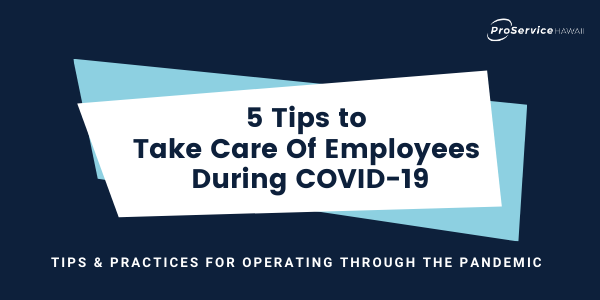Our Top 5 Tips to Take Care of Employees During COVID-19
Managing a company through a pandemic is no easy feat.
As employers, we bear the responsibility of keeping employees and customers safe if we are open for business.
In our recent webinar, Caring for People in the COVID Storm (now available on-demand), we heard from business leaders in the healthcare industry who shared candidly not only what they’re facing on the frontlines of COVID-19, but how they are keeping their teams safe in doing so.
Here are our top insights and takeaways.
1. Educate, train, communicate, repeat!
While everything around them was shutting down, healthcare facilities had to keep their doors open. This meant they needed to anticipate protocols, regulations, and changes on a whim and make the adjustments immediately with their team. So how did these essential businesses keep their team safe through it all? The answer: employee education and training.
Our featured leaders could not stress enough how frequent training and education had become the key to ensuring their teams were safe and healthy while under their roof. They also encouraged constant communication. The more owners talk about what is happening, the more it becomes normalized. The more managers communicate with their teams, the easier procedures are to enforce. Plus, constantly communicating with employees is a great way to reassure them that you are adequately prepared for every scenario.
2. Get people focused on your workplace facts
Although some may doubt the realities of COVID, employees (and customers) must understand that regardless of their beliefs and opinions, your workplace policies come first! Since this pandemic is a fluid situation, your company’s safety policies and procedures should be clearly articulated and presented in the most digestible way. This both communicates what you expect, but also what the consequences are if expectations aren’t met.
3. Safety is your responsibility (not someone else’s)
Because of long wait times, relying on the state’s contact tracing program has proven to be more harmful than helpful. Our panelists encouraged businesses to implement their own micro systems to manage threats and prevent the spread of COVID-19 in their workplaces. When it comes to safety, you have to look out for your own (and not depend on the work of others).
For example, one panelist shared how they created a process for tracing and logging connections from positive cases within their own organization. Having immediate information on hand was critical for containing and preventing further spread.
ProService’s three key steps for managing a positive COVID case was also reiterated as a way to ensure information is shared and spread is contained within a workplace:
- Take immediate action – Communicate with the infected person(s) and send them home immediately.
- Minimize the spread – Contain people who may have been in contact with the infected person while cleaning and sanitizing the spaces they frequented.
- Take care and offer support – Listen to their concerns, answer questions, and show them that you care.
4. Come together around your mission
The #1 priority among our panelists was making sure their employees felt safe and confident doing their jobs. A big #2 was encouraging employees to stay anchored in the mission of the business and remaining employees about why they do the hard and difficult work they do. When people are aligned with a common goal, it creates a sense of purpose and fuels motivation and engagement, especially when the tough gets going.
5. An emotionally safe workplace matters too
Our panelist talked about how burnout, fatigue, and stress were among the biggest challenges for employees on the frontlines of COVID-19. Managing their fears and anxiety was something the business needed to address. It’s not just about physical safety, but emotional safety too. Here were a few of their tips to consider:
- Create a space where they can air and voice their concerns. Make sure it’s private and that they feel like they are being heard.
- Give them choices. Let them know that they have the power to ultimately do what feels right to them.
- Continue pre-covid activities that employees enjoyed such as team and culture building exercises even if done remotely.
Get information and share information!
In conclusion, remember there is no right or wrong answer. Lots of employers are working through what feels right for their companies. Lean on other business owners and find out their best practices. Constantly learning and sharing information helps normalize our new workforce reality.









